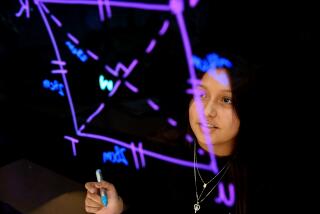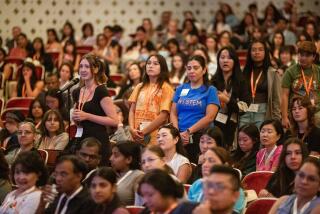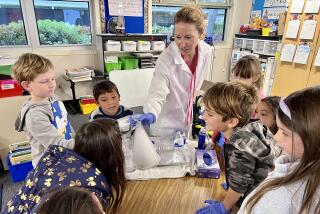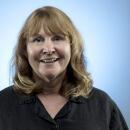Rites of Spring Include Science
- Share via
Longtime science teacher Dee Strange calls it “the onslaught.”
She refers to that chaotic morning each spring when the middle-school students descend on her classroom laboratory--sometimes with frazzled parents in tow--tugging three-sided display boards and assorted paraphernalia: their science projects.
“Leave your backpacks outside, OUTSIDE!” cautioned a lab-coated Strange one recent morning. “They’ll knock over somebody’s hard work, and then we’ll have tears.”
Narrowly averting collisions with their classmates’ delicate or bulky offerings, the seventh-graders scrambled to set up their projects on rapidly filling counter tops and disappearing floor space before hustling off to their first-period classes at Hermosa Valley School in Hermosa Beach.
Most probably were not aware that they were participating in a phenomenon that has become as much a rite of spring as filing income taxes and switching to daylight saving time. As the technology-conscious ‘90s stretch toward a close, the science project--along with its close companion, the science fair--is extending its reach into ever more households with school-age youngsters.
Participation in long-established fairs has grown steadily in the last few years, and new ones are popping up like wildflowers in the Santa Monicas after a wet winter.
*
Organizers of the 45th annual California State Science Fair, which begins today at the Los Angeles Sports Arena, expect about 900 participants--first-, second- and third-place winners, in various categories, from this spring’s county and regional fairs. Displays may be viewed by the public today from 4:30 to 6:30 p.m. and from 7:15 to 8 p.m.
“We’ve grown every year since the early 1990s,” said Robyn McGuire, a private-industry microbiologist and chair of the committee of volunteers that helps the California Museum of Science and Industry host the state fair each year. McGuire said the growth would be even more dramatic if it were not for limited display space and financial constraints on the privately funded fair.
“We’re literally running out of room, and we’ve been growing even while funding has been harder to get,” McGuire said.
The recent 47th annual Los Angeles County Science Fair drew 720 projects, about 100 of which qualified for entry in the state fair.
Newer fairs also are attracting interest. The East L.A. Sheriff’s Youth Activities League drew 500 projects last month with its first fair and plans to make it an annual event. The South Bay Business Environmental Coalition, which includes several large corporations ranging from oil and aerospace firms to a garbage hauler, saw participation in its sixth annual fair jump to 202 entries this year, up from last year’s 85.
The recent spurt in fairs’ popularity stems from schools’ increasing emphasis on math and science and the growing numbers of cash prizes, scholarships and other awards, many provided by corporate sponsors or private organizations.
The county fair, for example, awarded about $6,000 in prizes in 15 categories in both middle- and high-school divisions. Private benefactors kicked in almost $7,000 more in special awards. All of the $30,000 in prizes to be awarded at the state fair this week has come from private sponsors.
The corporate sponsorship reflects concerns by civic and business leaders about American students’ lagging achievement in science and mathematics. Studies have consistently shown that American students score well behind their counterparts in many Asian and European countries that are among the nation’s chief competitors in an increasingly global economy.
Just this month, the National Assessment of Educational Progress reported that a majority of American students cannot apply scientific facts and principles or clearly explain their reasoning--and California students, ranked 39th in the nation, were even further behind.
“In today’s society, you really need to know how to ask the right kinds of questions,” said McGuire, the scientist overseeing the state fair. Doing a science project provides a student “with a way of looking around you analytically and understanding more about what is going on,” she said.
Some schools encourage pupils as young as 5 to prepare science projects, albeit without the competitive factor of fairs for middle-and high-school students.
Projects tend to test the mettle of even the most supportive parents; they scramble to find materials, nervously oversee experiments involving dangerous, hot or stain-producing elements, and struggle to keep their patience while coaxing along a procrastinating or frustrated youngster.
All the while, parents wrestle with just how involved they should get.
Jeannie Bone frantically combed several shops for a prism on the weekend before daughter Jennifer’s project on light and rainbows was due. Then she spent hours helping the first-grader ready her work for display earlier this month at Campbell Hall, a kindergarten-through-12th-grade private school in North Hollywood.
*
“We had a month’s notice, but we did it on the weekend, and it was pretty nerve-racking,” said Bone, who found herself juggling the demands of her full-time job with Jennifer’s eagerness to do the project.
Campbell Hall’s younger students are not required to do a project, and those who voluntarily participate in the school’s science fair do not compete among themselves (“though I think some of the parents do,” Bone said).
But Bone was pleased that her daughter wanted to do a project. And when she saw Jennifer begin to grasp how sunshine makes rainbows, and how happy she was to be part of the fair, she decided it had been well worth the hassle.
“I was glad she got the message that science is something for girls to do, and she loved it. She’s got lots of ideas for next year,” Bone said.
Late on the night before her children’s projects were due at Holy Family School, a parochial school in South Pasadena, Chris McClain found herself awash in materials for making crystals, a topic both 9-year-old Katie and 5-year-old Timothy had chosen to explore.
“Everywhere I looked around the room, there was all this stuff--crystal-making solutions, books, poster board. My son was actually sitting on top of his poster board, frantically writing,” McClain said. Katie’s alum crystals turned out beautifully, but the rock candy she also attempted fizzled.
“We had a solid brick of sugar,” McClain said. “She was upset, but she got over it when I pointed out that she could still write up a report on it and try to figure out and explain why it hadn’t worked.”
Having prided herself on limiting her role to one of support and encouragement, McLain said she was a little taken aback when she saw some of the projects on display at open house night.
“You’d look at some and say to yourself, ‘I wonder what parent did this,’ and then I started to wonder if I should have done more,” she said.
But the seasoned pros say McClain did the right thing--and claim they can spot a parent-dominated project a mile away.
“The key is, what did the kid learn? Was the topic something the student was interested in? I can usually tell that as soon as they start talking about their project,” said Hermosa Valley’s Strange.
She once required a student to start over with a new topic after determining that the parent had done the work while the boy knew little about it; he earned a good grade on the second go-round.
Strange, who has been in the classroom long enough to teach some of the sons and daughters of her earlier students, recalled some projects with memorable results. A child who researched scoliosis, a debilitating spinal curvature, grew up to work with afflicted children. The family of a child who researched maple syrup struck up a lasting friendship with a distant family in the sugar maple business.
Duane Nichols is a longtime science teacher at Alhambra High School whose students earned first-place awards in seven of 15 categories at the county fair this year. Most had such eye-popping titles as Gordon Kwan’s entry in chemistry: “Ring Closing Metathesis of Ene-Yene Systems Using a Ruthenium Based Catalyst.” But it isn’t only the esoteric that deserves notice, Nichols said.
“Sometimes we look at a molecular biology project and say, ‘That must be a great project,’ but I have had students who have done really great projects on much more everyday issues,” Nichols said, citing a student who spent two years studying corn he grew in his backyard.
*
The county science fair offered plenty of examples of projects closely linked with the familiar. Hilda Gomez of Los Angeles’ Jefferson High, for example, studied “Yeast and Its Effects on Bread Dough with Different Temperatures,” while Sara Zommick, an eighth-grader at Brentwood Academy, had an entry on “The Inherent Dangers of Mascara When Not Properly Cared For.”
And Ben Freedland, a seventh-grader at Westchester Neighborhood School, won third place in the junior division behavioral and social sciences category with his experiment on “How Do Different Styles of Music Affect Babies’ Heart Rates?”
The hardest part, he said, was finding enough babies. He located five among neighbors and relatives, and found another five by visiting the family clinic where his mother is a nurse.
The next obstacle proved to be taking the infants’ pulses.
“The babies kept moving around a lot,” Ben said. “It took me an hour to test the first one, but after a while I was able to do them in 20 minutes.”
More to Read
Sign up for Essential California
The most important California stories and recommendations in your inbox every morning.
You may occasionally receive promotional content from the Los Angeles Times.











